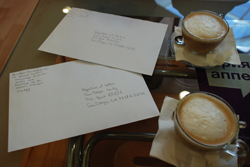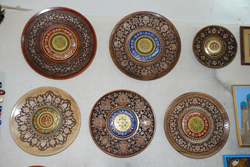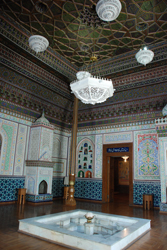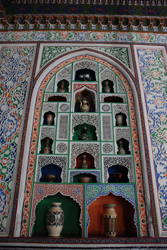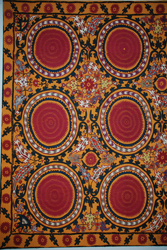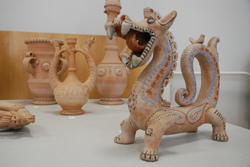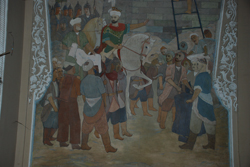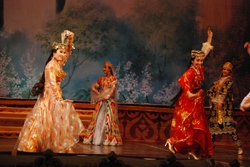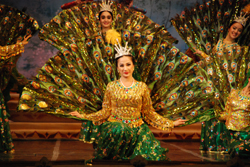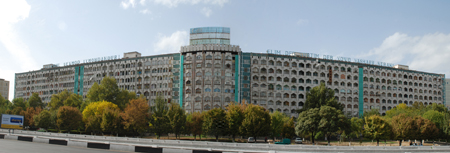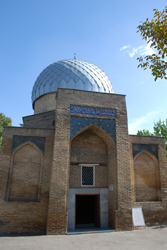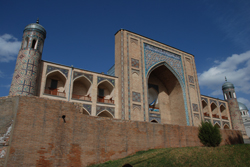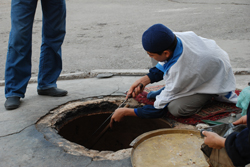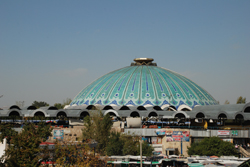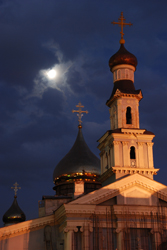Tashkent: How We Voted
15 October, 2008, 02:49 am in "Uzbekistan"
We voted today and when you think about it, it took a lot of work.
July--Istanbul, Turkey: I started investigating how we could vote. The main problem was that since we were traveling, we didn't have an address, the ballot could be sent to. I asked at the US consulate if the ballot could be sent to the embassy in Uzbekistan but they said no. I started searching on-line and found the Overseas Vote Foundation and contacted them. They responded to register for an absentee ballot, leave forwarding
addresses, and if we didn't receive our ballot in time, use the emergency on-line write-in ballot.
September--Osh, Kyrgyzstan: We decided it was time to register. After visiting about 5 different Internet places, we finally found one that was fast enough to use the Low-Bandwith version of the Overseas Vote Foundation site, would allow us to print, and had Acrobat reader. We managed to print out the registration form but then learned it had to be mailed.
Mid-September—Dushanbe, Tajikistan: We wanted to mail the registration forms from a major city. The first major city we reached was Dushanbe. Lonely Planet describes Tajikistan's postal service as “...a bit ropey and it's not uncommon for mail to take a month or more to reach its destination.” We hoped that mailing something from the capital would have better results. We paid extra to have it certified and the postal worker told us it would take 2 weeks and put numerous official labels on it.
Mid-October—Tashkent,Uzbekistan: The registrar confirmed that our ballots had been sent to Turkey but unfortunately they didn't reach us in Uzbekistan. It was time to fill out the on-line emergency write in ballot. This time we managed to find a wireless connection so we were able to fill out the ballots on our computer. However, we still had to find a place that could print them. Knowing that many internet places here for some bizarre reason don't have Adobe Acrobat Reader (it's FREE!!!) and don't let people download and install new software on their computers, we converted the ballot Acrobat form to a jpg image so we would have more of a chance to print it out. We printed it out and then went to look for an express mail service to send it. The only place we found was DHL and they charged $60. We decided we didn't care about voting THAT much so we looked for other options. Fortunately, the US Embassy in Tashkent sent out an e-mail informing us that we could mail the ballots free through them. Since it was already to late to get to the Embassy, we decided to go the next day.
In the morning, we left the hotel to go to find the embassy, thinking we'd grab envelopes on the way. We didn't see any in the bazaar and couldn't find single envelopes in the department store. We went to another part of town and tried a book/stationary store we'd seen but they didn't have any. Finally someone directed us to the TSUM (Central Shopping Center) where we found envelopes. It had taken 2 hours. The embassy was out of the center and took us an hour to get there. The embassy is a fortress. The embassy had been bombed at some point so they did have a legitimate reason to be nervous. As we approached, a guard looked at us with some kind of special binoculars (probably to detect if we had weapons or explosives). After talking to us through an intercom, they nervously let me in. Rowshan kept my bag and stayed outside, making the guards inside even more nervous. I sent my money belt through the x-ray machine and then assured them I had neither weapons nor chewing gum (!!!) They let me walk through the metal detector and pointed me towards the consular services section. Once there I had to fill out a special outside envelope and seal the ballots and cover forms inside. 15 minutes later we were done. It took us another hour to get back to the center (though this was partly because we were directed to the wrong bus.) That is how we voted. It was a lot of effort and time especially since we are registered in California which is not a swing state. However, it was Rowshan's first presidential election and I'd been kicking myself for not voting in the 2000 election. Anyway, I've said before if you don't vote, you have no right to complain about the outcome and I did quite a lot of complaining (definitely a lot more than the time it took us to vote this election) after the outcome of the 2000 election.
I'm writing this last part after the election. Both Rowshan and I overjoyed that Obama won. If anyone asks in the future we can reply, “We voted for Obama even though we were traveling at the time and had no address” instead of “Uh...well... we were for Obama but didn't vote.”
Art in Tashkent
14 October, 2008, 02:49 am in "Uzbekistan"
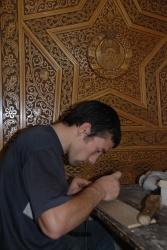 The Abulkasim Medressa, unlike the medressas in Samarkand, had craftsmen working: wood carvers, miniature painters, etc. I was glad to finally see people carving wood since I've seen so many beautiful examples around Central Asia. The guys we watched seemed young and were working on small pieces but there were plans rendered in water color on the walls for chaihanes and columns.
The Abulkasim Medressa, unlike the medressas in Samarkand, had craftsmen working: wood carvers, miniature painters, etc. I was glad to finally see people carving wood since I've seen so many beautiful examples around Central Asia. The guys we watched seemed young and were working on small pieces but there were plans rendered in water color on the walls for chaihanes and columns.The museum of Applied Arts is in a house which once belonged to a Russian diplomat, A. Polovtsov who collected Uzbek applied art. The house was built in the late 19th century and the interior and exterior patio is covered with ornate plaster (ganch) carvings, and detailed paintings. The ceilings were splendid and dripped with color and a jungle of floral designs and filigree.
Every space of the wall was covered with either ganch or tilework. There were ganch filigree niches which housed ceramics and a ganch chandelier from the ceiling. Even the fireplace/stove was covered with ganch. A smaller room had wall paintings with scenes of a potter and others.
The museum had rooms (many had been added on to the original house later) with ceramics, suzani, instruments, ikat, embroidery in gold, jewelry, wood carvings, metalwork and miniatures. The exhibits were interspersed between shops but at least the people working in them weren't pushy as in other places we've been. Everything was full of decoration. The exciting thing is these pieces weren't antiques but part of a tradition that is still very much alive. You can still find beautiful woven silks and detailed suzani. They are not only for past royalty as pieces you often see in museums.
Uzbek Dance Performance
The “must do” activity in Tashkent is going to the Opera or Ballet since tickets are incredibly cheap. When we went to the theatre to get tickets, we saw there was a performance of traditional Uzbek and world dance by the National Dance Ensemble Sabo. We got tickets to that instead. The interior of the Alisher Navoi Opera and Ballet Theatre is beautiful with paintings and traditional decoration. The performance started out very professionally with a whimsical colorful set utilizing ethnic pattern and design and theatrical dance. The first half was a selection of Uzbek dances featuring elegant arm and hand movements and positions. Some dances seemed more folky and playful others graceful and elegant. In a piece called Lagan, the dancer balanced a plate on various parts of body and spun it, somehow managing to spin it back up his body after spinning it down.
The dance of the peacocks started out the 2nd half. The movement seemed based on Uzbek dance but the music sounded Chinese and the dance was reminiscent of some Chinese animal dances. The dancers mimicked peacocks with head movements and a fanable tail piece to their dresses.
From there the performance went into a variety of mediocre performances of world dances and an awful “show group” of gold lame clad singers/dancers singing bad pop songs. Oh well. At least the first half contained beautiful skilled dancing.
Tashkent
11 October, 2008, 02:49 am in "Uzbekistan"
Our first impression of Tashkent was that it sucked. Huge ugly Soviet block buildings rose through hazy polluted air. For our first day we visited a couple 15th century mausoleums hidden in some back streets. Then we went to the “Old Town” to the bazaar.
The old town didn't seem very old-- just run down. There was a mosque and medressa. Behind it we saw what looked like someone poking around in a manhole. As we got closer we saw a young man was making samsas and the “manhole” was an oven. I do, however, have the sneaky suspicion it was a manhole first since I've never seen a samsa oven built into the ground next to a street.
One thing that really stands out in Tashkent are some of the really hideous examples of Soviet fusion architecture-- in which they tried to fuse aspects of Persian/Islamic architecture—namely blue domes-- with Soviet architecture—such as metal scaffolding, concrete blocks and a sense of aesthetics gained by slamming your face against a wall. The result in the best of circumstances looks like an amusement park based on the Jetsons and in the worst case it looks just plain ugly. The bazaar is of the concrete and blue dome variety which is similar to the circus building-- a giant concrete flying saucer from a 1950s alien invasion movie. Since the bazaar is the center of the old town, it looks like a bunch of aliens landed.
In Park Navoi, there is a bizarre dome on concrete pillars as part of a stadium-- the People's Friendship Palace. Though these do add some color and humor to the landscape, most of the other architecture isn't that interesting. Tashkent, aside from the ugly buildings, also seems to have some swank Nouveau Riche areas with the usual cosmopolitan assortment of brand name stores. This area is known as the Russian part of town (as opposed to the the Uzbek Old Town), even though I think many of the swank places are owned by Turkish people.
One of the weird things you see in Uzbekistan is beggars holding huge wads of cash or with plastic shopping bags in front of them with piles of bills. Of course, this is just because there really isn't any change. The smallest bill is worth about 8 cents and the largest, about 80 cents. In the evening we walked past a Russian Orthodox church as the moon rose. From inside we could hear singing. It seemed strangely out of place among all the concrete buildings of the area.
One of the weird things you see in Uzbekistan is beggars holding huge wads of cash or with plastic shopping bags in front of them with piles of bills. Of course, this is just because there really isn't any change. The smallest bill is worth about 8 cents and the largest, about 80 cents. In the evening we walked past a Russian Orthodox church as the moon rose. From inside we could hear singing. It seemed strangely out of place among all the concrete buildings of the area.
Powered by My Blog 1.69. Copyright 2003-2006 FuzzyMonkey.net.
Created by the scripting wizards at FuzzyMonkey.net..
(Code modified by Rowshan Dowlatabadi)
Created by the scripting wizards at FuzzyMonkey.net..
(Code modified by Rowshan Dowlatabadi)


